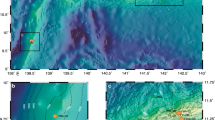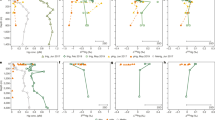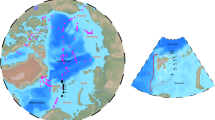Abstract
Mercury enters marine food webs in the form of microbially generated monomethylmercury. Microbial methylation of inorganic mercury, generating monomethylmercury, is widespread in low-oxygen coastal sediments. The degree to which microbes also methylate mercury in the open ocean has remained uncertain, however. Here, we present measurements of the stable isotopic composition of mercury in nine species of marine fish that feed at different depths in the central North Pacific Subtropical Gyre. We document a systematic decline in δ202Hg, Δ199Hg and Δ201Hg values with the depth at which fish feed. We show that these mercury isotope trends can be explained only if monomethylmercury is produced below the surface mixed layer, including in the underlying oxygen minimum zone, that is, between 50 and more than 400 m depth. Specifically, we estimate that about 20–40% of the monomethylmercury detected below the surface mixed layer originates from the surface and enters deeper waters either attached to sinking particles, or in zooplankton and micronekton that migrate to depth. We suggest that the remaining monomethylmercury found at depth is produced below the surface mixed layer by methylating microbes that live on sinking particles. We suggest that microbial production of monomethylmercury below the surface mixed later contributes significantly to anthropogenic mercury uptake into marine food webs.
This is a preview of subscription content, access via your institution
Access options
Subscribe to this journal
Receive 12 print issues and online access
$259.00 per year
only $21.58 per issue
Buy this article
- Purchase on Springer Link
- Instant access to full article PDF
Prices may be subject to local taxes which are calculated during checkout



Similar content being viewed by others
References
Sunderland, E. M. Mercury exposure from domestic and imported estuarine and marine fish in the US seafood market. Environ. Health Perspect. 115, 235–242 (2007).
Fitzgerald, W. F., Lamborg, C. H. & Hammerschmidt, C. R. Marine biogeochemical cycling of mercury. Chem. Rev. 107, 641–662 (2007).
Sunderland, E. M., Krabbenhoft, D. P., Moreau, J. W., Strode, S. A. & Landing, W. M. Mercury sources, distribution, and bioavailability in the North Pacific Ocean: Insights from data and models. Glob. Biogeochem. Cycles 23, GB2010 (2009).
Hammerschmidt, C. R. & Bowman, K. L. Vertical methylmercury distribution in the subtropical North Pacific Ocean. Mar. Chem. 132–133, 77–82 (2012).
Cossa, D. et al. Mercury in the Southern Ocean. Geochim. Cosmochim. Acta 75, 4037–4052 (2011).
Cossa, D., Averty, B. & Pirrone, N. The origin of methylmercury in open Mediterranean waters. Limnol. Oceanogr. 54, 837–844 (2009).
Mason, R. P. & Fitzgerald, W. F. Alkylmercury species in the equatorial Pacific. Nature 347, 457–459 (1990).
Choy, C. A., Popp, B. N., Kaneko, J. J. & Drazen, J. C. The influence of depth on mercury levels in pelagic fishes and their prey. Proc. Natl Acad. Sci. USA 106, 13865–13869 (2009).
Cossa, D. et al. Influences of bioavailability, trophic position, and growth on methylmercury in Hakes (Merluccius merluccius) from Northwestern Mediterranean and Northeastern Atlantic. Environ. Sci. Technol. 74, 4885–4893 (2012).
Mason, R. P. et al. Mercury biogeochemical cycling in the ocean and policy implications. Environ. Res. 119, 101–117 (2012).
Bloom, N. S. On the chemical form of mercury in edible fish and marine invertebrate tissue. Can. J. Fish. Aquat. Sci. 49, 1010–1017 (1992).
Van der Velden, S., Dempson, J. B., Evans, M. S., Muir, D. C. G. & Power, M. Basal mercury concentrations and biomagnification rates in freshwater and marine food webs: Effects on Arctic charr (Salvelinus alpinus) from eastern Canada. Sci. Total Environ. 444, 531–542 (2013).
Mason, R. P. & Fitzgerald, W. F. The distribution and biogeochemical cycling of mercury in the equatorial Pacific Ocean. 40, 1897–1924 (1993).
Cossa, D., Martin, J. M., Takayanagi, K. & Sanjuan, J. The distribution and cycling of mercury species in the western Mediterranean. Deep Sea Res. II 44, 721–740 (1997).
Monperrus, M. et al. Mercury methylation, demethylation and reduction rates in coastal and marine surface waters of the Mediterranean Sea. Mar. Chem. 107, 49–63 (2007).
Lehnherr, I. St, Louis, V. L., Hintelmann, H. & Kirk, J. L. Methylation of inorganic mercury in polar marine waters. Nature Geosci. 4, 298–302 (2011).
Heimbürger, L. E. et al. Methyl mercury distributions in relation to the presence of nano and picophytoplankton in an oceanic water column (Ligurian Sea, North-western Mediterranean). Geochim. Cosmochim. Acta 74, 5549–5559 (2010).
Kraepiel, A. M., Keller, K., Chin, H. B., Malcolm, E. G. & Morel, F. M. Sources and variations of mercury in tuna. Environ. Sci. Technol. 37, 5551–5558 (2003).
Blum, J. D. in Handbook of Environmental Isotope Geochemistry (ed. Baskaran, M.) Ch. 15, 229–246 (Springer, 2011).
Bergquist, B. A. & Blum, J. D. Mass-dependent and -independent fractionation of Hg isotopes by photo-reduction in aquatic systems. Science 318, 417–420 (2007).
Senn, D. B. et al. Stable isotope (N, C, Hg) study of methylmercury sources and trophic transfer in the northern Gulf of Mexico. Environ. Sci. Technol. 44, 1630–1637 (2010).
Point, D. et al. Methylmercury photodegradation influenced by sea-ice cover in Arctic marine ecosystems. Nature Geosci. 4, 188–194 (2011).
McClelland, J. W. & Montoya, J. P. Trophic relationships and the nitrogen isotopic composition of amino acids in plankton. Ecology 83, 2173–2180 (2002).
Rodriguez-Gonzalez, P. Species-specific stable isotope fractionation of mercury during Hg(II) methylation by an anaerobic bacteria (Desulfobulbus propionicus) under dark conditions. Environ. Sci. Technol. 43, 9183–9188 (2009).
Kritee, K., Barkay, T. & Blum, J.D. Mass dependent stable isotope fractionation of mercury during microbial degradation of methylmercury. Geochim. Cosmochim. Acta 73, 1285–1296 (2009).
Gantner, N., Hintelmann, H., Zheng, W. & Muir, D. C. Variations in stable isotope fractionation of Hg in food webs of Arctic lakes. Environ. Sci. Technol. 43, 9148–9154 (2009).
Laffont, L. et al. Anomalous mercury isotopic compositions of fish and human hair in the Bolivian Amazon. Environ. Sci. Technol. 43, 8985–8990 (2009).
Perrot, V. et al. Higher mass-independent isotope fractionation of methylmercury in the pelagic food web of Lake Baikal (Russia). Environ. Sci. Technol 46, 5902–5911 (2012).
Sherman, L. S. & Blum, J. D. Mercury stable isotopes in sediments and largemouth bass from Florida lakes, USA. Sci. Total Environ. 448, 163–175 (2013).
Gehrke, G. E., Blum, J. D., Slotton, D. G. & Greenfield, B. K. Mercury isotopes link mercury in San Francisco Bay forage fish to surface sediments. Environ. Sci. Technol. 4, 1264–1270 (2011).
Kritee, K., Blum, J. D., Johnson, M. W., Bergquist, B. & Barkay, T. Mercury stable isotope fractionation during reduction of Hg(II) to Hg(0) by mercury resistant bacteria. Environ. Sci. Technol. 4, 1889–1895 (2007).
Donovan, P. M., Blum, J. D., Yee, D., Gehrke, G. E. & Singer, M. B. An isotopic record of mercury in San Francisco Bay sediment. Chem. Geol. 349–350, 87–98 (2013).
Sherman, L. S., Blum, J. D., Keeler, G. J., Demers, J. D. & Dvonch, J. T. Investigation of mercury pollution from a coal fired power plant using mercury isotopes. Environ. Sci. Technol. 46, 382–390 (2012).
Zheng, W. & Hintelmann, H. Isotope fractionation of mercury during its photochemical reduction by low-molecular-weight organic compounds. J. Phys. Chem. A 114, 4246–4253 (2010).
Kwon, S. Y. et al. Absence of fractionation of mercury isotopes during trophic transfer of methylmercury to freshwater fish in captivity. Environ. Sci. Technol. 46, 7527–7534 (2012).
Stramma, L. et al. Expansion of oxygen minimum zones may reduce available habitat for tropical pelagic fishes. Nature Clim. Change 2, 33–37 (2012).
Stramma, L., Johnson, G. C., Sprintall, J. & Mohrholz, V. Expanding oxygen-minimum zones in the tropical oceans. Science 320, 655–658 (2008).
Choy, C. A. et al. Global trophic position comparison of two dominant mesopelagic fish families (Myctophidae, Stomiidae) using amino acid nitrogen isotopic analyses. PLoS ONE 7, e50133 (2012).
Chikaraishi, Y. et al. Determination of aquatic food-web structure based on compound-specific nitrogen isotopic composition of amino acids. Limnol. Oceanogr. Methods 7, 740–750 (2009).
Acknowledgements
We thank J. Pitz, A. Asato and S. Bailey for assistance with THg analyses; and K. Busscher and observers of the PIRO Longline Observer Program for sample collection. Financial support was provided to J.D.B. by the John D MacArthur Professorship and National Science Foundation (NSF) grant EAR-0952108. Additional financial support was provided by NSF grant OCE-1041329 (to B.N.P and J.C.D.), the Pelagic Fisheries Research Program (to J.C.D. and B.N.P.) and University of Hawaii Sea Grant Award RFM-27PD. Any opinions, findings and conclusions or recommendations expressed in this material are those of the authors and do not necessarily reflect the views of the NSF or NOAA. This is SOEST contribution number 8947.
Author information
Authors and Affiliations
Contributions
J.D.B. supervised Hg isotope measurements and co-wrote the manuscript, B.N.P. supervised determinations of trophic position and co-wrote the manuscript, J.C.D. supervised sample collection and contributed to data interpretation, C.A.C. carried out Hg concentration and N isotope measurements and contributed to data interpretation, and M.W.J. carried out Hg isotope measurements and contributed to data interpretation.
Corresponding author
Ethics declarations
Competing interests
The authors declare no competing financial interests.
Supplementary information
Supplementary Information
Supplementary Information (PDF 606 kb)
Rights and permissions
About this article
Cite this article
Blum, J., Popp, B., Drazen, J. et al. Methylmercury production below the mixed layer in the North Pacific Ocean. Nature Geosci 6, 879–884 (2013). https://doi.org/10.1038/ngeo1918
Received:
Accepted:
Published:
Issue Date:
DOI: https://doi.org/10.1038/ngeo1918



